75 Degrees Celsius To Fahrenheit
defexpoindia
Sep 22, 2025 · 4 min read

Table of Contents
Converting 75 Degrees Celsius to Fahrenheit: A Comprehensive Guide
Converting between Celsius and Fahrenheit is a common task, particularly for those working in scientific fields, cooking, or simply wanting to understand weather reports from different parts of the world. This article will comprehensively guide you through the process of converting 75 degrees Celsius to Fahrenheit, explaining the underlying formula, providing step-by-step instructions, and exploring the practical applications of this conversion. We’ll also delve into the history of these temperature scales and address some frequently asked questions.
Understanding the Celsius and Fahrenheit Scales
Before we begin the conversion, let's briefly understand the two scales. The Celsius scale, also known as the centigrade scale, is a metric unit based on the freezing and boiling points of water at standard atmospheric pressure. Water freezes at 0°C and boils at 100°C. The Fahrenheit scale, on the other hand, is a unit primarily used in the United States. Water freezes at 32°F and boils at 212°F.
The Conversion Formula: From Celsius to Fahrenheit
The formula for converting Celsius (°C) to Fahrenheit (°F) is:
°F = (°C × 9/5) + 32
This formula is derived from the relationship between the freezing and boiling points of water in both scales. The factor 9/5 accounts for the difference in the scale's intervals, while adding 32 adjusts for the difference in their zero points.
Step-by-Step Conversion of 75°C to Fahrenheit
Now, let's convert 75°C to Fahrenheit using the formula:
-
Substitute the Celsius value: Replace °C in the formula with 75. This gives us:
°F = (75 × 9/5) + 32
-
Perform the multiplication: Multiply 75 by 9/5:
75 × 9/5 = 135
-
Add 32: Add 32 to the result from step 2:
135 + 32 = 167
-
Final Result: Therefore, 75°C is equal to 167°F.
Practical Applications of the Conversion
Understanding how to convert between Celsius and Fahrenheit is crucial in various situations:
- Cooking and Baking: Many recipes specify temperatures in either Celsius or Fahrenheit. Accurate conversion is essential for achieving the desired outcome.
- Science and Engineering: Scientific experiments and engineering projects often require precise temperature control, necessitating accurate conversions between the two scales.
- Meteorology: Weather reports may use either Celsius or Fahrenheit, making conversion necessary for understanding weather conditions in different regions.
- Medicine: Body temperature is often measured in both scales, requiring conversion for accurate diagnosis and treatment.
- International Travel: Understanding temperature scales is vital when traveling internationally to prepare for different climates and weather conditions.
A Deeper Dive into the History of Temperature Scales
The Celsius and Fahrenheit scales have distinct origins. Anders Celsius, a Swedish astronomer, proposed a scale in 1742 where 0° represented the boiling point of water and 100° represented the freezing point. This was later reversed to the scale we use today. Daniel Gabriel Fahrenheit, a German physicist, developed his scale in 1724, basing it on a mixture of ice, water, and ammonium chloride (0°F), the freezing point of water (32°F), and human body temperature (96°F – later revised to 98.6°F).
Variations and Considerations
While the formula provided is standard, minor variations may exist due to differing atmospheric pressures. The boiling and freezing points of water are slightly affected by altitude and atmospheric pressure. However, for most everyday conversions, the standard formula provides sufficient accuracy.
Frequently Asked Questions (FAQ)
Q: Why is the conversion formula not a simple ratio?
A: The formula isn't a simple ratio because the scales have different zero points and different interval sizes. The 9/5 factor accounts for the different interval sizes, and the +32 adjusts for the differing zero points.
Q: Can I convert Fahrenheit to Celsius?
A: Yes, the reverse conversion formula is:
°C = (°F − 32) × 5/9
Q: Are there other temperature scales?
A: Yes, several other temperature scales exist, including the Kelvin scale, which is an absolute temperature scale used extensively in science. The Kelvin scale starts at absolute zero, where no thermal energy remains.
Q: What is absolute zero?
A: Absolute zero is the lowest possible temperature, theoretically where all molecular motion stops. It's 0 Kelvin (-273.15°C or -459.67°F).
Q: How accurate is the conversion?
A: The conversion is highly accurate for most practical applications. However, minor discrepancies may occur due to variations in atmospheric pressure.
Conclusion: Mastering Celsius to Fahrenheit Conversions
Mastering the conversion between Celsius and Fahrenheit is a valuable skill with numerous practical applications. Understanding the formula, its derivation, and the historical context enriches your understanding of temperature measurement. By following the simple steps outlined above and understanding the principles involved, you can confidently convert temperatures between these two commonly used scales. This knowledge will serve you well in various aspects of your life, from cooking to scientific endeavors and everything in between. Remember the formula (°F = (°C × 9/5) + 32) and you’ll always be ready to tackle any temperature conversion challenge!
Latest Posts
Latest Posts
-
9 Cm How Many Mm
Sep 22, 2025
-
Watt To Kilowatt Hour Converter
Sep 22, 2025
-
Height 65 Inches In Feet
Sep 22, 2025
-
Motor Kw To Hp Converter
Sep 22, 2025
-
Convert 26 Inches To Cm
Sep 22, 2025
Related Post
Thank you for visiting our website which covers about 75 Degrees Celsius To Fahrenheit . We hope the information provided has been useful to you. Feel free to contact us if you have any questions or need further assistance. See you next time and don't miss to bookmark.